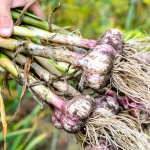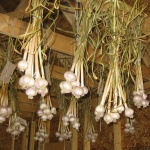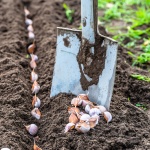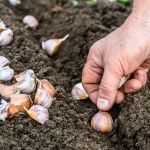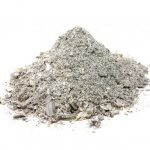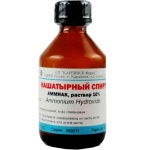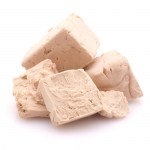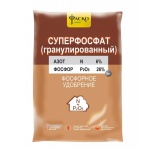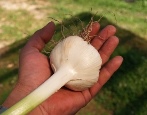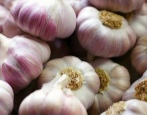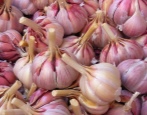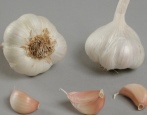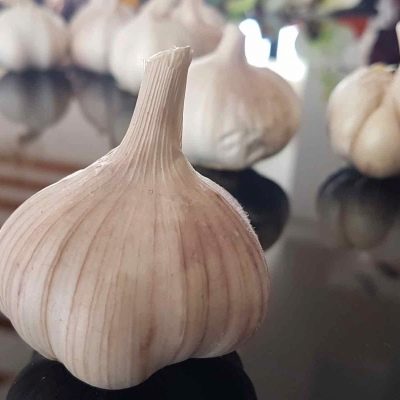
- Authors: Bogolepova N.I., Melchenko V.P., Egorov A.M., Artyushchenko N.A., Sevostyanova Z.A.
- Year of approval: 1999
- Sheet length, cm: 35,1
- Sheet width, cm: 1,3
- Leaf color: green with a waxy bloom of medium intensity
- The form: round (30%) and flat round (70%)
- Bulb weight, g: 21-23
- Number of teeth: 16
- Clove weight, g: 2-5
- Dry scales: white
Elenovsky garlic is one of the popular varieties of Russian selection with good yield indicators. It is suitable for winter storage, well adapted for reproduction with chives and air bulbs. The variety receives high marks from breeders and gardeners, and has good commercial prospects.
Breeding history
Yelenovsky was entered into the Russian state register in 1999. The selection of the variety was carried out by specialists of the Federal State Budgetary Scientific Institution "FNTs RISA" from Krasnodar under the leadership of NI Bogolepova.
Description of the variety
Spring variety, universal purpose. Does not shoot. It is able to maintain its consumer properties for up to 2 years. It tolerates transportation well.
Characteristics of the appearance of plants and bulbs
Elenovsky garlic forms stems 50-70 cm high. The leaves reach a length of 35.1 cm and a width of 1.3 cm. They are sharp, pointed, colored green, with a waxy bloom of medium intensity on the surface.
The heads are heterogeneous, about 30% of them are round in shape, the rest are flat-round. The weight of the bulbs varies in the range of 21-23 g, the cloves weigh about 2-5 g. The number of cloves in each reaches 16 pieces. Dry scales of this variety of garlic are white, the pulp is creamy pink. The structure of the heads is dense.
Purpose and taste
Semi-sharp garlic, not too hot, with a bright aroma. It is widely used in cooking, making marinades, and canning vegetables.
Maturation
Yelenovsky - mid-season garlic. From the emergence of seedlings to yellowing of the leaves, an average of 110-115 days pass.
Yield
The average collection rates reach 26-37 centners / ha, the yield is assessed as high.
Growing regions
This variety of garlic is successfully grown all over Russia: from the North Caucasus to the Far East. Yelenovsky is planted in Western and Eastern Siberia, in the Central Black Earth Region and in the Central Federal District.
Landing dates
For this variety of garlic, spring planting is recommended according to the 10x20 cm scheme. The choice of the term depends on climatic conditions, but the soil should warm up to + 2-3 degrees, and the snow should almost completely melt.
Growing and caring
The main requirements for caring for plants are timely and regular watering, maintaining the soil in a loose state. Elenovsky is fed for the first time after the appearance of 3-4 leaves. A mixture based on superphosphate, ammonium nitrate and potassium chloride is used.

You can plant garlic twice a year. The spring species is best planted in the spring, the winter one is sown before winter. Planting time depends on the region, climatic conditions, varieties, favorable days. It is also necessary to properly prepare the planting material and beds.
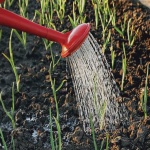
Soil requirements
The soil in the garlic bed should be moist and nutritious, loamy or sandy loam. The optimum pH is 6.5-7.9. The soil is previously plowed deeply, saturated with humus or compost.
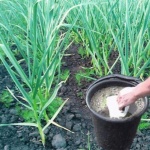
Top dressing of garlic plays a vital role in growing. The use of fertilizers contributes to the rapid growth of heads, an improvement in taste, and an increase in yield. There are many ways to feed him: this can be done with mineral or organic substances, as well as with all kinds of folk remedies.
Required climatic conditions
The variety is winter-hardy, drought-resistant. Adapted to most external threats. Tolerates spring return frosts without loss. For timely ripening, it needs planting in open sunny areas.
Disease and pest resistance
The variety is resistant to major diseases and pests of bulbous crops. The nematode is affected weaker than the standard.
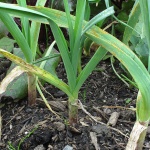
Review overview
Summer residents give high marks to the Yelenovsky garlic variety. Among the advantages in reviews about it, one can single out the absence of arrows, which is characteristic of spring varieties. At the same time, many vegetable growers also grow the variety as a winter one, getting earlier shoots, strong and strong, resistant to external factors. Among other advantages, a very high immunity is distinguished. Even without the use of preventive measures, the variety rarely gets sick.
Very high frost resistance also distinguishes Yelenovsky from the general series. It is suitable for conveyor cultivation. Self-collected seed material (air bulbs) retains all the characteristics of the variety. This garlic is not striking in size, but gives stable yields, has a pleasant taste with a slight piquancy, and is easy and good to peel.
The disadvantage of Yelenovsky is considered his sensitivity to the choice of the landing site. In the shade, it is difficult to expect record harvests from him. In addition, this variety, according to summer residents, is not the most popular, but reliable and stable.
